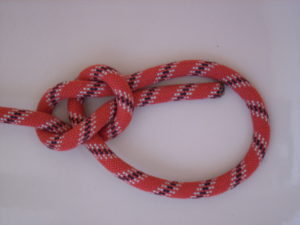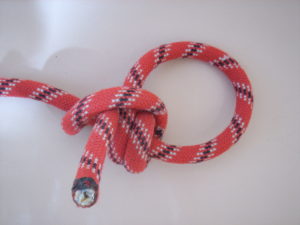Here are 4 knots you need to know if you participate in outdoor activities such as backpacking, boating, climbing, and caving. Knot tying is a useful skill for various applications, from securing gear to saving a life. These four are particularly valuable and easy to learn!
1. Bowline Knot

The bowline received its name because it was traditionally used by sailors to affix the sail to the bow (front) of the boat. In the present era, it is referred to as the “King of Knots” because it is suited for many applications. This knot makes a secure loop which can be lengthened to any size and does not slip under tension. The loop can then be secured to an anchor point, such as a rock, post, or tree.
Uses:
- Safety harness for lowering individuals
- Securing yourself (as a safety) to pass through difficult terrain
- Docking a boat or other similar purpose requiring a secure anchor on one end
Steps
- Make an initial loop near the end of the rope
- Pass the longer end of the rope up through the loop
- Pass the end around the start of the rope from right to left
- Pass the end down into the new loop and tighten
The scouts have a mnemonic to remember how to tie this knot, “The rabbit comes out of the hole, around the tree, and back in the hole”. The loop is the rabbit’s hole, one end of the rope is the rabbit, and the opposite end of the rope (where the knot begins) is the tree the rabbit goes around.
Instructional step by step videos
http://www.animatedknots.com/bowline/
http://www.howcast.com/videos/57-How-To-Tie-a-Bowline-Knot
2. Two Half Hitch

The two half hitch knot is used to hitch (secure) an object to a fixed object such as a tree, pole, post, or ring.
Uses:
- Moor boats to posts
- Hang a clothesline
- Secure equipment to the top of your vehicle’s luggage rack
- Hang a hammock to a tree
Steps:
- Form a loop around an anchor object, and wrap the short end of the rope over and under the longer part of the rope.
- Pass the end of the rope down the loop and pull tight to complete the ‘half hitch.’
- Repeat the loop below the first half to complete the second half hitch.
- Tighten to finish.
Instructional step by step videos
http://www.animatedknots.com/roundturn
http://www.howcast.com/videos/180-How-To-Tie-a-Two-Half-Hitch-Knot
Two Half Hitch Tip
Use the taut line hitch if you are tying one end of the rope to a stake.
3. Taut Line Hitch

This fast & adjustable knot is ideal for applications in which you need the rope to slide in one direction or to periodically adjust the tightness. Since it will only slide one way, the taut-line hitch is often used for tying tent and tarp grommets to a tree or stake.
Uses:
- Tents
- Clothesline
Steps
- Form a loop around an anchor object, and wrap the short end of the rope over and under the longer part of the rope.
- Pass the end of the rope down the loop and pull tight to complete the ‘half hitch.’
- Bring the end of the rope to the front of the loop and make another half-hitch.
- Snug the hitch firmly around the end of the rope. Slide the knot along the rope to adjust as necessary.
Instructional step by step videos
http://www.animatedknots.com/rollinghitchboating/
http://www.howcast.com/videos/52-How-To-Tie-a-Taut-Line-Hitch-Knot
4. Square Knot

Also referred to as a reef knot, this is a quick, easy, and secure way to tie two different ropes together. It ties and unties easily and will not slip or jam. It is also used to tie two ends of a single line together to secure a bundle of objects – such as firewood. You can loosen the square knot easily by pushing the ends toward the knot.
Uses:
- Tie off bandages in first aid
- Secure packages
- Bundle firewood
- Tie shoelaces to prevent them from unraveling
Join two ends together to make a handle, such as for trash bags
Steps:
- Tie a knot by holding the rope parallel to the ground and crossing the right side over the left and tighten.
- Tie a second knot in the opposite direction (left over right) and tighten.
The knot should lie flat when tied with the ends of the knot pointed in the same direction as the rope.
Instructional step by step video
http://www.animatedknots.com/reef
Square Knot Tip:
Be careful that you don’t tie a granny knot! The granny knot is tied twice in the same direction. It slips and fails to hold.

5 thoughts on “Top 4 Useful Knots”
Square knot is a great knot, but knot for tying two ropes together to make a longer rope! If this is what you’re looking to do, Google a sheetbend. Just thought I’d share 🙂
Nice
Reef knot lies flat so makes an excellent bandage knot. For joining two ropes choose sheet, double sheet or double fishermen bends.
A bowline knot for a harness or any kind of repel sounds crazy dangerous. That knot can shake loose when not under tension. Any ledge on the way down that relieves tension on the road is a huge safety hazard!
The bowline is the only one i know how to do, i use it for everything outdoors even though there are probably others that are better suited. Nice post!